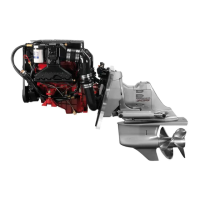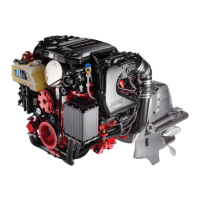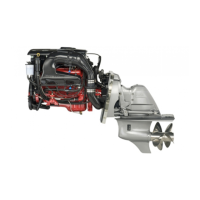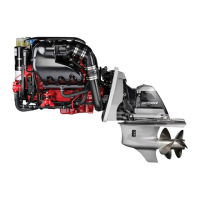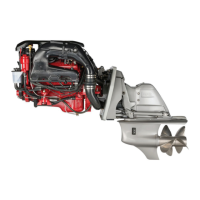Do you have a question about the Volvo Penta V6 Series and is the answer not in the manual?
Introduction to the Volvo Penta marine engine and owner experience.
Outlines Volvo Penta's core values guiding operations and activities.
Lists the Volvo Penta engine models covered by this manual.
Explains coverage of Forward Drive units in the manual.
Provides guidance on obtaining the correct manual and its purpose.
Explains how safety information is presented in the manual.
Provides essential safety guidelines for operating a boat.
Discusses carbon monoxide hazards, sources, and symptoms.
Details CO risks and precautions during stationary boat operation.
Discusses CO risks and backdrafting effects during underway operation.
Explains backdrafting and its impact on CO concentration.
Warns about chemicals and health risks associated with marine vessel operation.
Directs users to warranty information provided with the engine.
Explains the network of authorized dealers for service and repair.
Guides users on finding the nearest Volvo Penta servicing dealer.
Provides the website for accessing manuals, service info, and dealer locations.
Provides contact information for customer relations in the US.
Describes the 24/7 phone-based breakdown and support service.
Explains the ignition switch and its key positions (A, O, I, S).
Describes the function of various gauges found on a boat.
Explains the engine status panel and its fault indications.
Introduces the power trim system and its benefits.
Details the operation of trim switches on the control lever.
Explains the function and types of trim gauges.
Describes the shift and throttle control lever, its features, and adjustment.
Explains the ACPS, its function, and LED indicator status.
Details the function, installation, and service of the optional seawater strainer.
Explains the hot water outlet system and its considerations.
Covers the optional air conditioning system and its operation warning.
Lists essential checks to perform before starting the engine.
Recommends essential tools and parts to have on board for preparation.
Details the step-by-step procedure before starting the engine.
Explains the auto-crank feature and how to start the engine.
Provides instructions on how to clear a flooded engine.
Outlines special procedures for the first 20 hours of engine use.
Guides on monitoring gauges and understanding their readings for safe operation.
Explains the function of the engine alarm and its warning signals.
Discusses safety precautions for maneuvering and operating the boat.
Details the operation of the shift and throttle control, including neutral interlock.
Explains the function and use of the safety lanyard (emergency stop switch).
Provides recommended cruising speeds and factors affecting fuel economy.
Introduces the trim and tilt systems for boat maneuvering and adjustment.
Details how to operate the trim system switches on the shift lever.
Explains the different trim ranges (Trim, Beach, Tilt) shown on gauges.
Guides on proper trimming for performance, including during takeoff.
Describes normal use and potential issues of the bow-up trim position.
Describes normal use and potential issues of the bow-down trim position.
Explains the motor protection mechanism against overheating.
Discusses boat steering system operation and potential issues.
Covers steering for twin engine setups.
Provides precautions for operating the engine in freezing temperatures.
Details precautions and procedures for operating in shallow water.
Discusses performance impacts and adjustments for high altitude operation.
Recommends flushing the engine after saltwater use.
Provides guidance for experienced operators handling high-performance boats.
Steps to take before shutting down the engine, including approaching the dock.
Details the procedure for properly stopping the engine.
Covers procedures after the engine is shut down, including operation break.
Explains engine flushing ports and the step-by-step flushing procedure.
Guidance on preventing AIS spread by cleaning, draining, and drying equipment.
Recommends the correct drive position when the boat is not in use.
Covers procedures for safely trailering the boat and drive.
Explains draining the engine, Easy Drain, hang tags, and seawater strainer procedures.
Details response procedures after striking an object or running aground.
Explains the drive's impact protection system.
Discusses the tie rod's role in twin steering systems and checks.
Outlines steps to take if the engine is submerged in water.
Provides instructions for jump-starting a drained battery.
Covers fundamentals of engine operation for troubleshooting.
Diagnoses issues when the engine fails to crank.
Diagnoses issues when the engine cranks but does not start.
Addresses difficulties starting a cold engine.
Addresses difficulties starting a hot engine.
Addresses starting issues that occur after the engine has been run.
Guides on diagnosing unusual engine noises and vibrations.
Diagnoses causes for rough engine running.
Identifies causes and solutions for engine overheating.
Addresses issues where the engine stops running unexpectedly.
Diagnoses why the engine fails to reach its operating RPM.
Addresses low oil pressure or engine knock symptoms.
Diagnoses low battery voltage after a period of storage.
Addresses a general reduction in engine or boat performance.
Explains how hull weight affects boat performance.
Discusses how boat bottom condition impacts performance.
Explains the engine protection mode and its indicators.
Addresses issues when the engine won't restart after running out of fuel.
Diagnoses and resolves engine overheating issues.
Addresses detection of water in the drive unit bellows.
Diagnoses water presence or low oil level in the drive unit.
Addresses issues related to the electric fuel pumps.
Guides on checking the fuse and relay box for electrical issues.
Explains the function of the engine status panel and its indicators.
Addresses common issues with the powertrim system.
Guides on diagnosing and resolving steering system problems.
Explains static water line measurement and its importance.
Details the procedure for testing the static water line.
Provides guidelines for accessing engine maintenance schedules.
Recommends contacting dealers for scheduled maintenance.
Highlights the importance of preventative maintenance for safety.
Defines basic inspections the owner should perform.
Outlines the owner's duty to maintain the power package.
Details warranty and maintenance requirements for emissions systems.
Explains the importance of hour meters for tracking service needs.
Provides basic guidance on performing own maintenance and repairs.
Warns against using non-marine parts for the engine.
Details safety procedures for shutting down the engine before service.
Explains the function and use of the auxiliary stop button.
Warns about potential damage from high-pressure washing.
Outlines special requirements for certified engines.
Identifies key service and maintenance points on the engine.
Covers general engine information and serpentine belt.
Covers scheduled oil service, oil level checks, and adding oil.
Covers fuel system, high pressure, ethanol gasoline, and filter replacement.
Covers impeller replacement and freshwater cooling system.
Covers checks for exhaust bellows, clamps, and anodes.
Covers ignition system maintenance, including spark plugs.
Covers electrical system maintenance, battery cables, and battery.
Covers drive unit lubrication, painting, and anti-fouling paint.
Details checking the powertrim/tilt fluid level.
Explains care and clearing of the pitot tube.
Covers anode inspection, replacement, and types.
Details the procedure to reset the oil sensor on OceanX drives.
Covers propeller care, damage checks, and replacement.
Details checking power steering reservoir fluid level.
Provides guidance on preparing the boat and engine for storage.
Outlines steps for storing the boat for up to two months.
Provides procedures for storing the boat for over two months.
Lists checklists for launching the boat after storage.
Specific checklist for bringing the boat out after short-term storage.
Specific checklist for bringing the boat out after long-term storage.
Provides engine specifications and RPM ranges.
Details engine oil specifications, requirements, and capacity.
Describes the engine oil filter and its replacement.
Covers octane requirements, ethanol, and biobutanol gasoline.
Provides coolant type and capacity information.
Details electrical system voltage, battery cables, and battery specs.
Provides drive unit lubrication types and capacities.
Lists where to find engine, drive, and transom assembly identification numbers.
Presents the declaration of conformity for emissions and sound.
Introduction to the Volvo Penta marine engine and owner experience.
Outlines Volvo Penta's core values guiding operations and activities.
Lists the Volvo Penta engine models covered by this manual.
Explains coverage of Forward Drive units in the manual.
Provides guidance on obtaining the correct manual and its purpose.
Explains how safety information is presented in the manual.
Provides essential safety guidelines for operating a boat.
Discusses carbon monoxide hazards, sources, and symptoms.
Details CO risks and precautions during stationary boat operation.
Discusses CO risks and backdrafting effects during underway operation.
Explains backdrafting and its impact on CO concentration.
Warns about chemicals and health risks associated with marine vessel operation.
Directs users to warranty information provided with the engine.
Explains the network of authorized dealers for service and repair.
Guides users on finding the nearest Volvo Penta servicing dealer.
Provides the website for accessing manuals, service info, and dealer locations.
Provides contact information for customer relations in the US.
Describes the 24/7 phone-based breakdown and support service.
Explains the ignition switch and its key positions (A, O, I, S).
Describes the function of various gauges found on a boat.
Explains the engine status panel and its fault indications.
Introduces the power trim system and its benefits.
Details the operation of trim switches on the control lever.
Explains the function and types of trim gauges.
Describes the shift and throttle control lever, its features, and adjustment.
Explains the ACPS, its function, and LED indicator status.
Details the function, installation, and service of the optional seawater strainer.
Explains the hot water outlet system and its considerations.
Covers the optional air conditioning system and its operation warning.
Lists essential checks to perform before starting the engine.
Recommends essential tools and parts to have on board for preparation.
Details the step-by-step procedure before starting the engine.
Explains the auto-crank feature and how to start the engine.
Provides instructions on how to clear a flooded engine.
Outlines special procedures for the first 20 hours of engine use.
Guides on monitoring gauges and understanding their readings for safe operation.
Explains the function of the engine alarm and its warning signals.
Discusses safety precautions for maneuvering and operating the boat.
Details the operation of the shift and throttle control, including neutral interlock.
Explains the function and use of the safety lanyard (emergency stop switch).
Provides recommended cruising speeds and factors affecting fuel economy.
Introduces the trim and tilt systems for boat maneuvering and adjustment.
Details how to operate the trim system switches on the shift lever.
Explains the different trim ranges (Trim, Beach, Tilt) shown on gauges.
Guides on proper trimming for performance, including during takeoff.
Describes normal use and potential issues of the bow-up trim position.
Describes normal use and potential issues of the bow-down trim position.
Explains the motor protection mechanism against overheating.
Discusses boat steering system operation and potential issues.
Covers steering for twin engine setups.
Provides precautions for operating the engine in freezing temperatures.
Details precautions and procedures for operating in shallow water.
Discusses performance impacts and adjustments for high altitude operation.
Recommends flushing the engine after saltwater use.
Provides guidance for experienced operators handling high-performance boats.
Steps to take before shutting down the engine, including approaching the dock.
Details the procedure for properly stopping the engine.
Covers procedures after the engine is shut down, including operation break.
Explains engine flushing ports and the step-by-step flushing procedure.
Guidance on preventing AIS spread by cleaning, draining, and drying equipment.
Recommends the correct drive position when the boat is not in use.
Covers procedures for safely trailering the boat and drive.
Explains draining the engine, Easy Drain, hang tags, and seawater strainer procedures.
Details response procedures after striking an object or running aground.
Explains the drive's impact protection system.
Discusses the tie rod's role in twin steering systems and checks.
Outlines steps to take if the engine is submerged in water.
Provides instructions for jump-starting a drained battery.
Covers fundamentals of engine operation for troubleshooting.
Diagnoses issues when the engine fails to crank.
Diagnoses issues when the engine cranks but does not start.
Addresses difficulties starting a cold engine.
Addresses difficulties starting a hot engine.
Addresses starting issues that occur after the engine has been run.
Guides on diagnosing unusual engine noises and vibrations.
Diagnoses causes for rough engine running.
Identifies causes and solutions for engine overheating.
Addresses issues where the engine stops running unexpectedly.
Diagnoses why the engine fails to reach its operating RPM.
Addresses low oil pressure or engine knock symptoms.
Diagnoses low battery voltage after a period of storage.
Addresses a general reduction in engine or boat performance.
Explains how hull weight affects boat performance.
Discusses how boat bottom condition impacts performance.
Explains the engine protection mode and its indicators.
Addresses issues when the engine won't restart after running out of fuel.
Diagnoses and resolves engine overheating issues.
Addresses detection of water in the drive unit bellows.
Diagnoses water presence or low oil level in the drive unit.
Addresses issues related to the electric fuel pumps.
Guides on checking the fuse and relay box for electrical issues.
Explains the function of the engine status panel and its indicators.
Addresses common issues with the powertrim system.
Guides on diagnosing and resolving steering system problems.
Explains static water line measurement and its importance.
Details the procedure for testing the static water line.
Provides guidelines for accessing engine maintenance schedules.
Recommends contacting dealers for scheduled maintenance.
Highlights the importance of preventative maintenance for safety.
Defines basic inspections the owner should perform.
Outlines the owner's duty to maintain the power package.
Details warranty and maintenance requirements for emissions systems.
Explains the importance of hour meters for tracking service needs.
Provides basic guidance on performing own maintenance and repairs.
Warns against using non-marine parts for the engine.
Details safety procedures for shutting down the engine before service.
Explains the function and use of the auxiliary stop button.
Warns about potential damage from high-pressure washing.
Outlines special requirements for certified engines.
Identifies key service and maintenance points on the engine.
Covers general engine information and serpentine belt.
Covers scheduled oil service, oil level checks, and adding oil.
Covers fuel system, high pressure, ethanol gasoline, and filter replacement.
Covers impeller replacement and freshwater cooling system.
Covers checks for exhaust bellows, clamps, and anodes.
Covers ignition system maintenance, including spark plugs.
Covers electrical system maintenance, battery cables, and battery.
Covers drive unit lubrication, painting, and anti-fouling paint.
Details checking the powertrim/tilt fluid level.
Explains care and clearing of the pitot tube.
Covers anode inspection, replacement, and types.
Details the procedure to reset the oil sensor on OceanX drives.
Covers propeller care, damage checks, and replacement.
Details checking power steering reservoir fluid level.
Provides guidance on preparing the boat and engine for storage.
Outlines steps for storing the boat for up to two months.
Provides procedures for storing the boat for over two months.
Lists checklists for launching the boat after storage.
Specific checklist for bringing the boat out after short-term storage.
Specific checklist for bringing the boat out after long-term storage.
Provides engine specifications and RPM ranges.
Details engine oil specifications, requirements, and capacity.
Describes the engine oil filter and its replacement.
Covers octane requirements, ethanol, and biobutanol gasoline.
Provides coolant type and capacity information.
Details electrical system voltage, battery cables, and battery specs.
Provides drive unit lubrication types and capacities.
Lists where to find engine, drive, and transom assembly identification numbers.
Presents the declaration of conformity for emissions and sound.
| Brand | Volvo Penta |
|---|---|
| Model | V6 Series |
| Category | Engine |
| Language | English |
